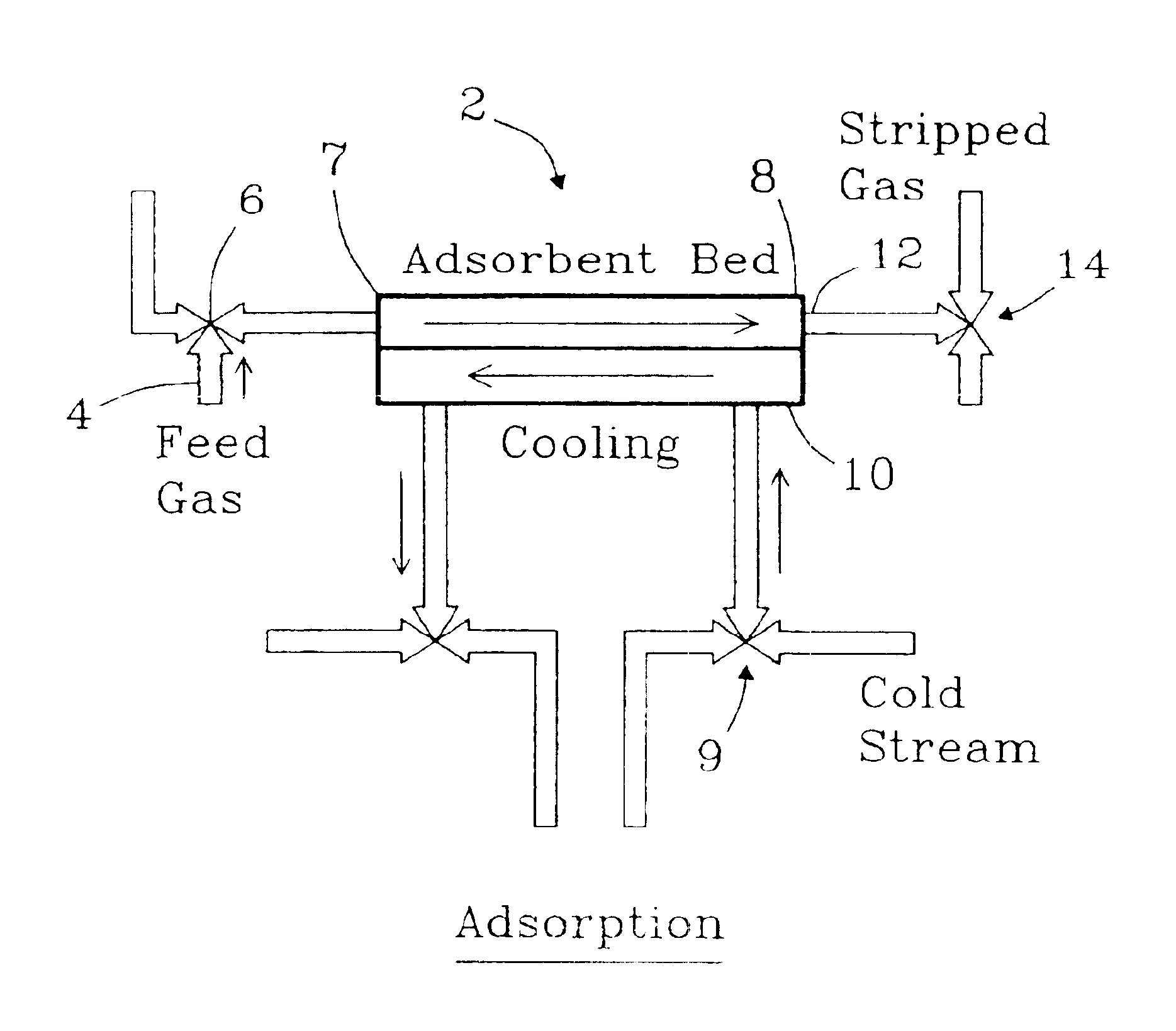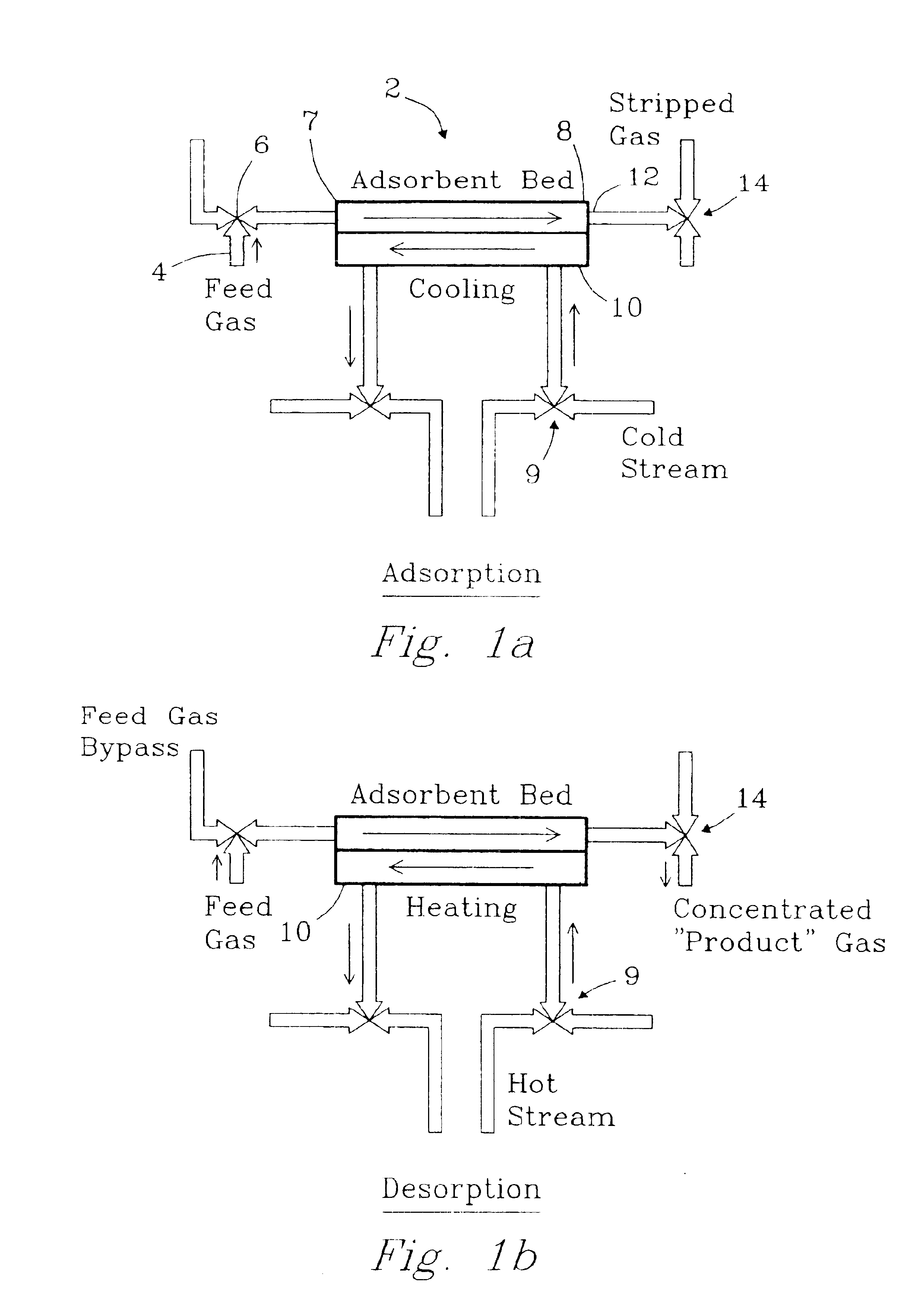Apparatus for thermal swing adsorption and thermally-enhanced pressure swing adsorption
a technology of apparatus and gas, applied in the direction of electrochemical generators, sustainable manufacturing/processing, separation processes, etc., can solve the problems of adsorption separation technology, use of excess energy, bulky apparatus, etc., and achieve the effects of reducing time and/or larger volumes, rapid sorbent regeneration, and excellent device stability
- Summary
- Abstract
- Description
- Claims
- Application Information
AI Technical Summary
Benefits of technology
Problems solved by technology
Method used
Image
Examples
example 1
Adsorbent Mass Reduction for Rapid Thermal Cycling
[0102]As a practical test case, consider the adsorption and desorption of pure CO2 from zeolite 13× at near atmospheric pressure. A vendor-supplied zeolite 13× isobar at 760-mm Hg CO2 pressure shows the equilibrium CO2 capacity q varies nearly linearly with temperature T, over the range of −50° C. to 100° C., per the relationship q=24.9-0.115T100=0.249-0.00115T(1)
Here, the units of q are kg CO2 / kg zeolite and T is in degrees Celsius (C). The theoretical working capacity per cycle qw for adsorption at a low bed temperature Tl and desorption at a higher temperature Th under the isobaric conditions is therefore expressed as qw=0.00115(Th-Tl)=0.00115 Δ T=mdesCO2mads(2)
The working capacity qw is the maximum amount of gas desorbed at Th when the gas is adsorbed to equilibrium loading at Tl. Experimentally, the actual working capacity was determined from the known amount of zeolite in the adsorbent bed and the volume of CO2 desorbed,...
example 2
Adsorbent Mass Reduction for a Thermochemical Compression Scheme
[0106]Example 1 describes an isobaric process, but many adsorption processes are not isobaric. Consider, for example, an application in which the goal is to achieve CO2 compression thermochemically using a mesochannel adsorption system. Here, it is proposed to use a thermal swing adsorption process to capture (adsorb) CO2 at low temperature and low pressure (e.g., ˜6 mm Hg) and deliver (desorb) CO2 at higher temperature and pressure (e.g., 760 mm Hg) to a fuel-producing chemical reactor. Since adsorption, not desorption, is favored by higher partial pressures of the adsorbed gas species, it is necessary to operate the thermal swing over a sufficient temperature range to have a net production of gas in each thermochemical compression cycle.
[0107]For demonstration purposes, we consider adsorption at −50° C. and 6 mm Hg of CO2 and desorption at 100° C. and 760 mm Hg of CO2, to provide greater than 125-times compression. Th...
example 3
Rapid Thermal Swing Adsorption Cycles in Mesochannel Devices Demonstrated
[0109]FIG. 7 shows the rapid thermal-swing capability for an all-metal mesochannel adsorber in a series of 1-minute heating and cooling phases. (In separate tests, it was determined that the heat-exchange surface measured temperatures depicted in the figure are representative of the zeolite bed temperature to within 1 to 2° C.). As the heat-exchange fluid flow rate was increased from 20 mL / min to 80 mL / min, the maximum and minimum adsorber temperatures approached the hot (70° C.) and cold (5° C.) reservoir temperatures. A larger temperature differential between adsorption and desorption cycles increases the zeolite working capacity, and therefore, a higher adsorbent working capacity is expected as the water flow rate is increased. FIG. 7 also shows that the approach to the maximum (or minimum) temperatures is faster with increasing heat-exchange fluid flow rate. The heating curves were fit to exponential decay ...
PUM
| Property | Measurement | Unit |
|---|---|---|
| Temperature | aaaaa | aaaaa |
| Temperature | aaaaa | aaaaa |
| Fraction | aaaaa | aaaaa |
Abstract
Description
Claims
Application Information
 Login to View More
Login to View More - R&D
- Intellectual Property
- Life Sciences
- Materials
- Tech Scout
- Unparalleled Data Quality
- Higher Quality Content
- 60% Fewer Hallucinations
Browse by: Latest US Patents, China's latest patents, Technical Efficacy Thesaurus, Application Domain, Technology Topic, Popular Technical Reports.
© 2025 PatSnap. All rights reserved.Legal|Privacy policy|Modern Slavery Act Transparency Statement|Sitemap|About US| Contact US: help@patsnap.com



